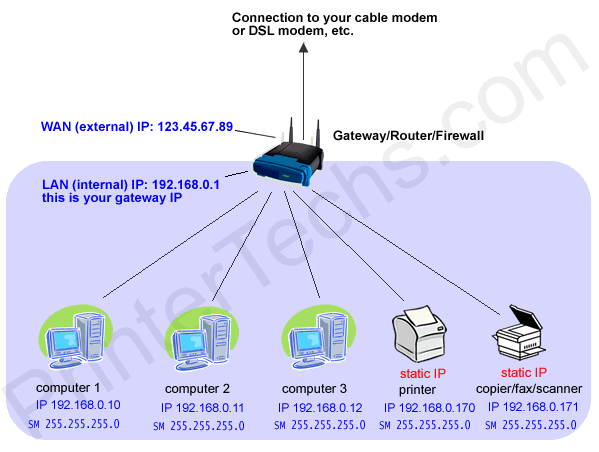Page 2 - How IP addresses and gateways work
To set up the JetDirect card, you will need an IP address and a subnet mask. If you don’t have a network administrator or resident computer guru to provide this info for you, then we will assume that you have a small office or home network and that person is you.
Below is a picture of a typical home or small office network.

If you have a DSL modem or cable modem you will typically have what is called a gateway or router. The terms gateway and router are often used interchangeably. In many cases the modem and gateway are combined in one unit. This device does quite a few things. It allows you to hook up many, potentially thousands, of devices to your network. The gateway has two IP address. One is an external IP address assigned by your ISP (internet service provider), and the other an internal IP address that is only accessible within your network. This internal IP address is also called you default gateway IP address (GW). All computers on your local network need to know the default gateway IP in order to access the internet.
Even though your ISP only assigns you one IP address, the gateway allows you to have many IP addresses through a technique called Network Address Translation (NAT). Read here for more http://en.wikipedia.org/wiki/Network_address_translation
It is also worth noting that there are specific IP addresses that are reserved for local networks called private IP addresses. Read here for more http://en.wikipedia.org/wiki/Private_network. You really don’t want to use non-private IP address schemes inside your network. Our example above uses the common 192.168.0.x IP scheme where x is a number between 0 and 255. More on that later.
Another function of the gateway is to automatically assign and manage IP addresses in your network. Remember that each device in your network must have a unique IP address. This feature is called DHCP – dynamic host configuration protocol. (DHCP is the successor to the older BOOTP protocol. Keep that in mind since you might run into the term BOOTP when setting up the JetDirect card). If you want to know more about DCHP look here http://en.wikipedia.org/wiki/Dhcp.
Having your gateway act as a DHCP server to assign IP addresses is a nice convenience because you don’t have to worry about configuring the network settings on all of the devices on your network; the DCHP server does it for you. IP addresses assigned this way are called dynamic IP addresses. Dynamic IP addresses can change. For example when a printer is turned off it looses its dynamic IP address. When it is turned back on the DHCP server assigns it another IP address. It might be the same IP address, but then again, it might not. If your printer had a dynamic IP address and its address changed, you wouldn’t be able to print. Your computer would be configured to print to the old IP address and the printer would no longer be there. Printers should therefore have static IP addresses. This requires that you manually configure the network settings of your printer.
For advanced users, some DHCP servers can assign the same IP address based on the MAC address (hardware address) of the JetDirect card. This would basically allow you to assign the IP address at the DHCP server, given you know the Mac address. The Mac address can be obtained by printing a configuration page, or sometimes it is printed on the JetDirect card.




